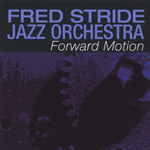Home » Jazz Articles » Album Review » Fred Stride Jazz Orchestra: Forward Motion
Fred Stride Jazz Orchestra: Forward Motion
In any case, one must concede that Stride's Vancouver-based ensemble unravels his elaborate charts with machine-like precision, adeptly underlining every nuance and shading while making certain that the assorted changes in tempo are squarely on the mark. Machina's opening movement comprises two parts: "Input, depicting "a type of computational machine, and "Process, which concerns itself with "the manipulation of data. Flugel Brad Turner solos on Part 1, guitarist Daryl Jahnke and trombonist Dennis Esson on Part 2. The second movement, "Colossus, portrays "very large machinery with very large solos to match by baritone saxophonist Mike Braverman and tubaist Brad Muirhead. The third movement, "Sound, delineates a mysterious machine that "can move abruptly from the softest to the loudest sound, while the final movement, "Velocity, is, as its name suggests, concerned with "machinery that is capable of tremendous speeds. Alto Campbell Ryga, trombonist Rod Murray and bassist Andre Lachance share center stage on "Sound, tenors Jon Bentley and Alvin Cornista on "Velocity.
The first half of the album, albeit comparably thematic, is explicitly more orthodox and accessible. The vigorous "Opposition Party, Stride writes, "is an attempt to depict the Canadian parliamentary system in musical terms (it's actually more conciliatory than the description implies). "Gently Swaying, a Latin chart in 7/4, speaks for itself, while "Floatation [sic] Device is an exercise in varying tempos, "A Few Shades Darker an extended blues with a "thick and somewhat dark texture, "Oddly Enough a rhythmic charmer that uses clarinets instead of saxophones in the ensemble passages (and on which clarinetist Tom Colclough sparkles with pianist Ross Taggart and drummer Bernie Arai). Tenors Bentley and Cornista engage in a lively debate on "Opposition Party, while Bentley, Colclough (alto) and flugel Tom Shorthouse are able protagonists on "Swaying, Ryga (alto) and Turner (trumpet) on "Device, Esson and trumpeter Derry Byrne on "Shades.
There's not a lot of ear candy on Forward Motion—Stride hasn't made things easy by aiming low—but discerning and open-minded listeners will uncover music that is both pleasurable and rewarding.
Track Listing
Opposition Party; Gently Swaying; Flotation Device; A Few Shades Darker; Oddly Enough; Machina: A Concert for Jazz Orchestra: Input-Process; Colossus; Sound; Velocity (79:28).
Personnel
Fred Stride
composer / conductorFred Stride: composer, arranger, conductor; Paul Baron, Derry Byrne, Brad Turner, Tom Shorthouse, Kent Wallace: trumpet, flugelhorn; Tom Colclough: alto, soprano sax, clarinet; Campbell Ryga (3,5,7): alto, soprano sax, bass clarinet; Chris Startup (1-4): alto sax; Jens Christiansen (5-9): alto sax, clarinet; Jon Bentley: tenor sax, alto clarinet; Alvin Cornista: tenor sax; Mike Braverman: baritone sax, bass clarinet; Dennis Esson, Rod Murray, Jeremy Berkman: trombone; Neil Nicholson (1-4), Brad Moorhead (5-9): bass trombone; Ross Taggart: piano; Daryl Jahnke: guitar; Andre Lachance: bass; Bernie Arai: drums; Jack Duncan: percussion.
Album information
Title: Forward Motion | Year Released: 2007 | Record Label: Cellar Live
< Previous
Chance Meeting
Next >
A Discontinuous Line
Comments
About Fred Stride
Instrument: Composer / conductor
Related Articles | Concerts | Albums | Photos | Similar ToTags
For the Love of Jazz
 All About Jazz has been a pillar of jazz since 1995, championing it as an art form and, more importantly, supporting the musicians who create it. Our enduring commitment has made "AAJ" one of the most culturally important websites of its kind, read by hundreds of thousands of fans, musicians and industry figures every month.
All About Jazz has been a pillar of jazz since 1995, championing it as an art form and, more importantly, supporting the musicians who create it. Our enduring commitment has made "AAJ" one of the most culturally important websites of its kind, read by hundreds of thousands of fans, musicians and industry figures every month.



















